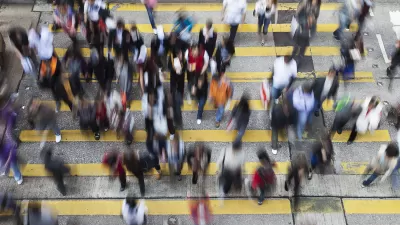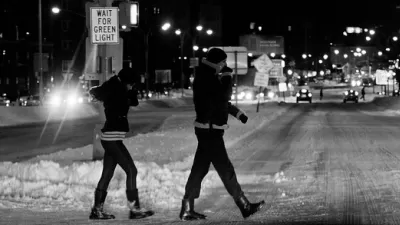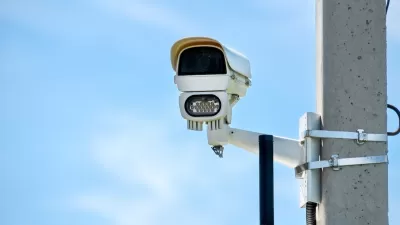New data released Dec. 19 by NHTSA shows increased safety for those traveling by car, but pedestrian fatalities are 15% higher than in 2009. Plans by San Francisco, Los Angeles, New York, and Chicago to increase ped safety are described by the WSJ.

The United States saw 4,735 pedestrian deaths in 2013, a slight decline from the previous year but still 15 percent higher than in 2009, according to National Highway Traffic Safety Administration [NHTSA] data [PDF] released (Dec. 19)," writes Andrew Tangel, transportation reporter for The Wall Street Journal. "That compares with the overall 32,719 traffic deaths the U.S. saw in 2013, a 3.1% decline from the previous year and continuing a long-term downward trend.
Much of the safety infrastructure and programs are being implemented in larger cities more likely to approach "a critical mass of foot and bike traffic to get drivers used to sharing the road, such as in some European locales, said Chandra Bhat, director of the Center for Transportation Research at the University of Texas at Austin.
“The general thinking among motorists still is, ‘The road is my road,’ ” he said.
Ed Reiskin, director of transportation at the San Francisco Municipal Transportation Agency and successor to New York City Transportation Commissioner Janette Sadik-Khan as president of the National Association of City Transportation Officials [NACTO], explains a fundamental problem challenging transportation planners:
“Many of our city streets were not really designed with pedestrians in mind,” said Ed Reiskin. They “were largely designed just to move and store private automobiles.”
San Francisco's "Vision Zero" program [PDF]—zero pedestrian deaths in 10 years, is "focused on the 6% of its streets that have seen 60% of serious pedestrian injuries and deaths," states Reiskin. An additional program was added in March, WalkFirst, "to target the most dangerous intersections in the city for safety improvements," as we noted earlier.
Last November, Proposition A, a $500 million bond passed with well over the 2/3 of votes threshold necessary. Safety for all road users is a crucial component. In addition, "Mr. Reiskin said officials may seek legislative changes to use cameras to catch lead-footed drivers and lower the city’s default speed limit of 25 miles per hour where none is posted," writes Tangel.
Los Angeles announced a similar program, zero pedestrian deaths by 2025, in September: Pedestrian infrastructure will play a key role, including changing traffic lights to include "leading pedestrian intervals" that "let pedestrians establish themselves in intersections before stoplights change and cars start turning."
New York City began their Vision Zero program when Mayor Bill de Blasio took office in January. The city "lowered the speed limit on about 90% of streets in its five boroughs to 25 mph from 30 mph," writes Tangel. Pedestrian fatalities are down substantially, to 109 as of Oct. 29 compared to 178 for all of last year, he notes, but they have a long way to go to achieve zero.
Chicago's pedestrian safety program [PDF], launched under then CDOT Commissioner Gabe Klein, also "aims for zero traffic deaths by 2022." It also relies partly on new infrastructure including "adding countdown clocks to crosswalks, speed humps and 'concrete bump-outs' that shorten crosswalks—part of a broad shift in focus to safety, said Rebekah Scheinfeld, the city’s transportation commissioner."
FULL STORY: Cities Target Elevated Levels of Pedestrian Deaths

Planetizen Federal Action Tracker
A weekly monitor of how Trump’s orders and actions are impacting planners and planning in America.

Map: Where Senate Republicans Want to Sell Your Public Lands
For public land advocates, the Senate Republicans’ proposal to sell millions of acres of public land in the West is “the biggest fight of their careers.”

Restaurant Patios Were a Pandemic Win — Why Were They so Hard to Keep?
Social distancing requirements and changes in travel patterns prompted cities to pilot new uses for street and sidewalk space. Then it got complicated.

Platform Pilsner: Vancouver Transit Agency Releases... a Beer?
TransLink will receive a portion of every sale of the four-pack.

Toronto Weighs Cheaper Transit, Parking Hikes for Major Events
Special event rates would take effect during large festivals, sports games and concerts to ‘discourage driving, manage congestion and free up space for transit.”

Berlin to Consider Car-Free Zone Larger Than Manhattan
The area bound by the 22-mile Ringbahn would still allow 12 uses of a private automobile per year per person, and several other exemptions.
Urban Design for Planners 1: Software Tools
This six-course series explores essential urban design concepts using open source software and equips planners with the tools they need to participate fully in the urban design process.
Planning for Universal Design
Learn the tools for implementing Universal Design in planning regulations.
Heyer Gruel & Associates PA
JM Goldson LLC
Custer County Colorado
City of Camden Redevelopment Agency
City of Astoria
Transportation Research & Education Center (TREC) at Portland State University
Camden Redevelopment Agency
City of Claremont
Municipality of Princeton (NJ)





























